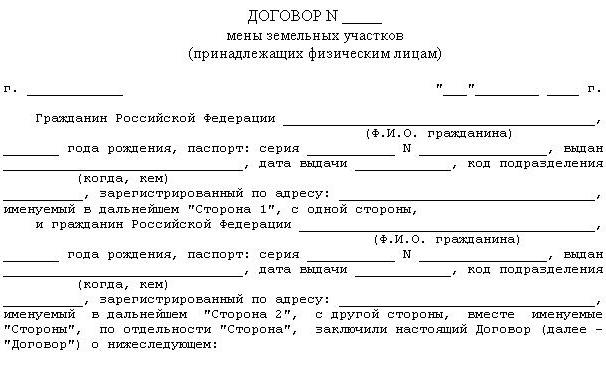The land exchange agreement refers to the transfer of land to the ownership of one party in exchange for another land. Since barter is a legal relationship on a reimbursable basis, then the general rules governing purchase and sale transactions are used with respect to it, with the specifics that are due to the very nature of this type of transaction.
Specificity of an exchange agreement
The main difference from the contract of sale is that for the transferred property, the parties receive not the monetary amount specified in the contract, but a land plot that has similar characteristics, properties and price. Both sides at the same time act as sellers and buyers.
Therefore, the areas they exchange should be approximately the same. But in reality it often happens that one site is inferior to another in some properties. In such a case, the parties have the right to establish the required payment for the difference in cost, the amount of which is prescribed in the terms of the exchange agreement.
The exchange differs from a donation agreement in that the nature of the transaction is onerous, and not carried out unilaterally as the transfer of land as a gift. If a land exchange agreement is concluded, each party receives either a similar property or partial compensation if one plot is inferior to the other.
Transaction Forms
In relation to the exchange of plots in the Russian Federation, such forms of transaction as:
- a simple written form when the parties to the contract should only certify it with signatures and transfer it further to the authorities of the Federal Registration Service for state registration;
- a notarial form in which the certification of this contract is not required, but in many cases is nevertheless prescribed by a regulatory act.

When is notarization required?
Notarization is required in the following cases:
- For transactions related to the site belonging to a minor or citizen who is recognized as having limited legal capacity.
- In the case of an exchange, if there is common ownership of the land plot (including those cases when all parties dispose of their shares in one transaction).
It doesn’t matter by what form the transaction is concluded, the exchange agreement (a sample will be presented below) must be registered by state authorities. If this requirement is not complied with, then the document is declared invalid.
Regulation
When concluding an agreement on the exchange of land plots, both parties must be mindful of the regulatory standards in terms of law that distinguish an agreement of this type from a contract of sale of the same land. For example, if there are no exact conditions in the agreement on the price of the land to be exchanged or data on the distribution of expenses of both parties, you need to remember the underlying assumption on the exchange of equivalent plots.
If, however, to execute the land exchange agreement, expenses are required for transferring the land to the other party or other actions that are aimed at fulfilling the agreement, then they must be carried out by the party that must do this in accordance with the prescribed obligations.
Compensation procedure for an unequal exchange
Initially, the agreement assumes the equivalence of land.That is why possible future disputes of participants about the value of the transferred property are very limited. If the subject of the contract is the exchange of unequal plots, the party that transfers the plot with a lower price receives another obligation to pay the difference in their value.
Such payment must be made before or immediately after the counterparty has been transferred to the site having a lower cost. At the same time, a different procedure for compensation of the existing price difference may be established in the exchange agreement. Therefore, it is quite natural that all the necessary requirements and the form of compensation paid must necessarily be reflected in the text itself when concluding the contract.
Simultaneous exchange
The exchange of land does not have to be carried out simultaneously. There are also cases when the agreement sets different dates for the transfer of exchanged plots. First, one party to the contract fulfills its obligations, and then another. If, according to the certified exchange agreement, the terms for the transfer to each other do not coincide, then it is necessary to apply the rules established by law on the counter fulfillment of their obligations, which are enshrined in article 328 of the Civil Code of the Russian Federation.
From its content it follows that if the counterparty fails to fulfill the contractual obligation, another counterparty has the right to immediately suspend further fulfillment of its own obligations that are specified in the agreement (a sample exchange agreement can also be seen in this article), or, in principle, refuse to comply with it. It may also require the other party to recover damages due to the violations it has committed.
The moment when the ownership right to the plots of land to be exchanged directly passes to its participant is determined in article 570 of the Civil Code of the Russian Federation. It says that the ownership of the land acquired through exchange is transferred simultaneously to each of the parties if all the obligations established by the contract were fulfilled before that.
In addition, it is necessary to note the specifics of the barter agreement, which relates to the responsibility for the seizure of property, that is, the land received under the exchange agreement. In the case of purchase and sale, the seller assumes the obligation to transfer to the buyer such goods that are free from the presentation of rights to it by third parties. There is only one exception to the requirements established by law when the buyer himself agrees to accept goods that are encumbered with the rights of third parties. A similar provision of legislation in the civil field applies to the barter agreement. If one of the parties fails to fulfill this obligation, the culprit not only compensates the counterparty for the losses incurred by him, but also returns to the bona fide participant the land received through exchange. On what conditions is a contract concluded?
Terms of an agreement
The main terms of the exchange agreement, which must be agreed upon by both parties, are:
- establishing the subject of the contract, that is, the plots transferred by both parties;
- identification of quantitative characteristics of contractual property;
- determination of the equivalence of the value and properties of the plots or the indication of appropriate compensation to achieve equivalence.
The essential terms of the transaction are agreed directly at the preparatory stage and are based on various title documents for land (for example, cadastral passports, reports on market value, etc.).
How to draw up a land exchange agreement for an apartment? About it further.
How is the contract drawn up?
In accordance with Article 550 of the Civil Code of the Russian Federation, an agreement on the sale of real estate must be in writing. The contract for the exchange of land is also subject to exclusively written conclusion.If the legal requirements for the form are not complied with, then the agreement is automatically considered invalid. An agreement of this kind obliges the state registration of new owners and their rights in the department of Rosreestr, which is located on the site of exchanged land.
Characteristics that personalize exchange objects
The contract must necessarily describe the features that personalize the plots to be exchanged:
- area of alienated land plots;
- their cadastral numbers;
- the purpose for which they are operated;
- real estate with an indication of their affiliation, which are located on these sites.
Registration of a land exchange agreement is a responsible matter.
Also, drawings of the plots that are the subject of the contract must be attached to the exchange agreement. Parties need to evaluate the respective plots at the cadastral value. In addition, it is necessary to evaluate the various structures and real estate objects that are located on this land. The assessment is made using the acts determining the cadastral value and the consolidated statements of the assessment of structures. These documents are attached to the exchange agreement.
When it is drawn up, the parties must provide their counterparties with the following information:
- on the presence or absence of land conflicts and disputes over plots to be exchanged, as well as their legal nature;
- the presence of existing easements;
- whether the land to be exchanged is being leased to a third party;
- on the transfer of this land as a pledge.

The boundaries of the territory to which third parties are entitled and the content of these rights should be indicated on the graphic plan of the respective sites. The agreement indicates restrictions on property rights that are associated with the technological, sanitary, protective and other zones established on this land, as well as with the assignment of land to a part or part of it to those that have environmental, recreational or cultural-historical purposes.
According to federal law, registration is considered to be the commission of a certain legal action by bodies having the appropriate authority. Thus, the ownership of the land occurs simultaneously with the registration of the rights of one or another party in relation to it. The procedure for registration and registration of the land exchange agreement under the land law is completed at the moment when the information is entered into the unified legal register and the documents are issued to the applicants.
The specifics of taxation of land after the conclusion of the contract
Since, in accordance with the contractual requirements, each of the parties not only alienates the land, but also obtains property that is identical in price and characteristics, the grounds for their taxation arise for any subject of the agreement.
Despite the fact that there is a rule on the equivalence of lands to be exchanged, it is not worth thinking that both parties will pay equal taxes for the plots acquired by them. The amount of a specific payment will be calculated by the relevant tax authority on the basis of the cadastral value, which may differ even for plots of the same type. In this situation, the parties have the right to challenge the land valuation in court and attempt to calculate the tax at its market price.
The intended use of land is a significant basis for the emergence of the right to exemption from tax payments.
Exchange of land for other objects
It is possible to implement a car exchange agreement for a land plot. In this case, the parties themselves are determined with the equivalence of the transaction. If any one of the objects of exchange is cheaper, then an additional charge will be made. It is clear that the owner loses ownership of the car and ownership of land is acquired.
Also, a contract of land exchange for a house or apartment is often concluded.